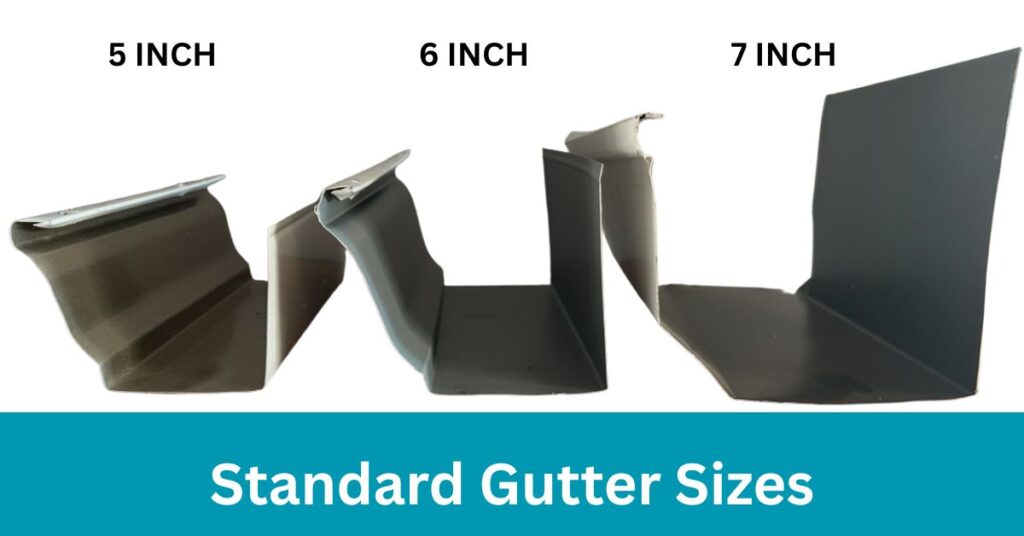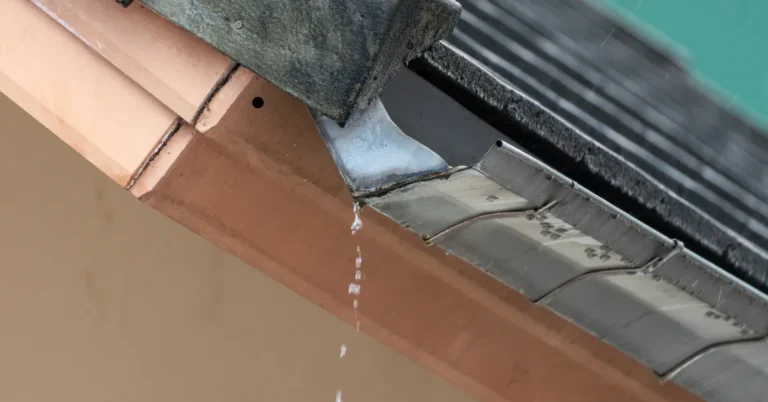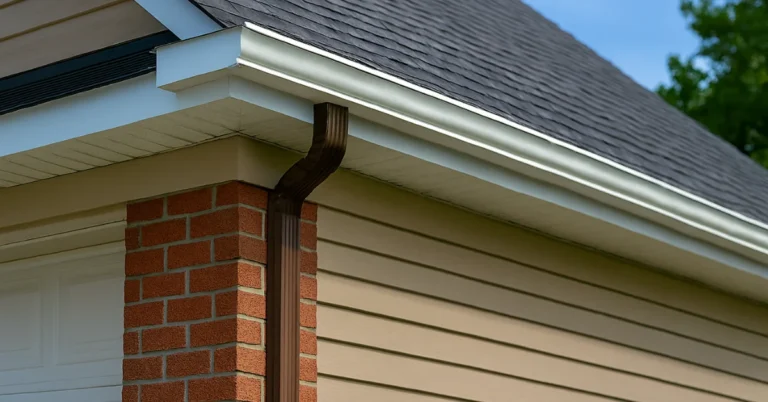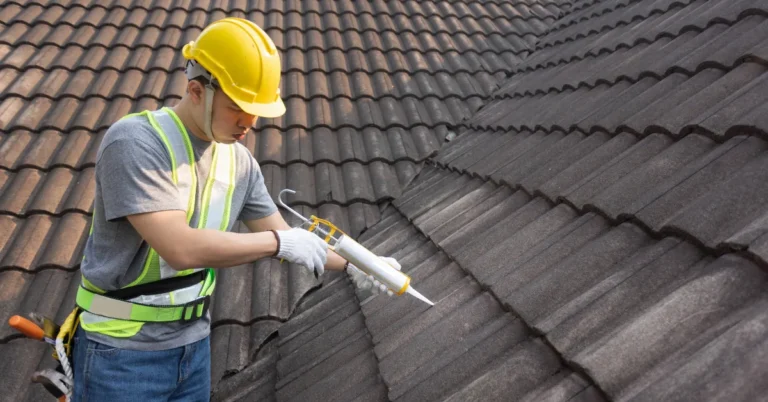When it comes to protecting your home or business from water damage, choosing the right gutter size is more important than most people realize. Gutter sizes directly affect how efficiently rainwater is collected and drained away from your roof. Too small, and your system can overflow during heavy rainfall. Too large, and you might be spending more than necessary.
What Are the Standard Gutter Sizes?
Gutters typically come in three main sizes: 5-inch, 6-inch, and 7-inch widths. Each size is designed to handle different volumes of water and is suited to specific types of properties. Choosing the right size depends on your roof area, local rainfall levels, and whether your property is residential, commercial, or industrial.

5-Inch Gutters
- Most common for residential homes
- Suitable for roof areas up to 4000 square feet
- Works well in regions with moderate rainfall
- Compatible with 2″x3″ downspouts
- Typically available in K-style or half-round profiles
6-Inch Gutters
- Popular for larger homes, garages, or light commercial buildings
- Ideal for roof areas between 4000– 7,800 square feet
- Handles heavier rainfall and steeper roof pitches
- Usually paired with 3″x4″ downspouts
- Offers greater water capacity and less chance of overflow
7-Inch or Oversized Gutters
- Used on commercial buildings, warehouses, and industrial properties
- Designed for very large roof surfaces and high-volume runoff
- Often custom-fabricated in materials like steel or copper
- May require special brackets and larger downspouts for support
Gutter Sizes Chart by Roof Area
Choosing the right gutter size starts with understanding your roof’s surface area. Larger roofs collect more rainwater, which means your gutters need to be wide enough to handle the flow without overflowing. Below is a quick-reference chart to help match your roof size with the appropriate gutter size.
| Gutter Size | Roof Area (sq ft) | Typical Use Case |
|---|---|---|
| 5 inch | Up to 5,500 sq ft | Standard homes, bungalows, townhouses |
| 6 inch | 5,500 to 7,800 sq ft | Larger residential homes, garages, light commercial buildings |
| 7+ inch | Over 7,800 sq ft | Commercial properties, industrial buildings, warehouses |
Pro Tip: To calculate your roof’s surface area, multiply the length x width of each roof section and add them together. Don’t forget to factor in roof pitch steeper roofs require gutters with greater capacity, even if the square footage is moderate.
Residential vs Commercial Gutter Sizes
Understanding the differences between residential and commercial gutter systems is key to choosing the right size for your building. While the function of all gutters is to manage rainwater, the design, size, and capacity vary depending on the property type.
Residential Gutter Sizes
For most homes, gutter sizing is relatively straightforward. 5-inch K-style gutters are considered the standard and are commonly installed on single-story and small two-story houses. These gutters work well for roof areas up to 5,500 square feet and are suitable for climates with moderate rainfall. However, for larger homes, steep-pitched roofs, or areas with frequent heavy downpours, 6-inch gutters are often the better choice. They offer more capacity and reduce the risk of overflow during intense storms.
Homeowners typically choose materials like aluminum (lightweight and cost-effective) or copper (for upscale aesthetics and durability). Profiles such as K-style and half-round are popular in residential settings because they balance performance with curb appeal.
Commercial Gutter Sizes
Commercial and industrial buildings have greater demands due to their larger roof areas and flat or low-slope designs. These factors require gutter systems that can manage significantly more runoff. As a result, 6-inch, 7-inch, or even 8-inch box-style gutters are often used to ensure proper drainage.
Commercial gutters are engineered not just for volume but also for compliance with local building codes, which often mandate minimum capacity and downspout sizing. Materials like galvanized steel, heavy-gauge aluminum, or custom-fabricated metals are used to withstand the demands of large-scale roofing and to last in harsh weather conditions. Oversized downspouts are also paired with these systems to prevent clogs and water buildup.
While residential gutters are chosen with both functionality and appearance in mind, commercial gutters are focused almost entirely on drainage capacity and durability.
5-Inch vs 6-Inch Gutters: Which is Better?
When it comes to choosing between 5-inch and 6-inch gutters, homeowners and contractors often weigh three key factors: water flow capacity, cost and maintenance, and aesthetics. While both sizes are widely used, each has advantages depending on the size of your roof, your local climate, and your design preferences.
Water Flow Capacity
The primary reason people upgrade to 6-inch gutters is for increased water-handling capacity. A 6-inch gutter can hold and drain nearly 40% more water than a 5-inch gutter. This makes a big difference in areas that experience heavy rainfall, or on homes with steep-pitched roofs that channel more water quickly.
For example, a typical 5-inch gutter works well for roof areas under 5,500 square feet. But if your roof is larger or more complex with multiple valleys and slopes, 6-inch gutters provide extra protection against overflow, leaks, and foundation issues.
Cost and Maintenance
While 6-inch gutters are more effective, they are also more expensive. Expect to pay about 10–20% more for materials and installation compared to 5-inch gutters. They also require larger downspouts (usually 3″x4″ instead of 2″x3″), which can slightly increase labor costs.
That said, the maintenance cost is relatively similar. In fact, 6-inch gutters may clog less frequently, especially if paired with proper leaf guards, because of their larger openings and better water flow. Over time, this could actually reduce maintenance needs.
Aesthetic Differences
From a design standpoint, 5-inch gutters have a more compact and subtle appearance, making them a popular choice for small to mid-sized homes. They blend well with standard rooflines and are available in a wide range of colors and materials.
6-inch gutters are larger and more noticeable, but this isn’t necessarily a drawback. On larger homes or properties with bold architectural features, 6-inch gutters can look balanced and even enhance curb appeal especially in premium materials like copper or painted steel.
Which One Should You Choose?
- Choose 5-inch gutters if your home is average-sized, in a mild climate, and you’re prioritizing budget and aesthetics.
- Go with 6-inch gutters if your roof is large, your area experiences heavy rain, or you want better long-term performance with fewer clogs.
Selecting the correct gutter sizes are not just about picking between 5-inch and 6-inch options. It involves calculating how much water your roof collects and drains during a typical rainstorm. To do this, you’ll need to consider your roof size, pitch (slope), and local rainfall intensity.
FAQs
Can I switch from 5” to 6” gutters?
Yes, upgrading is possible and common especially for larger roofs or areas with heavy rain. You will also need to upgrade your downspouts for proper flow.
Do larger gutters improve drainage?
Yes. A 6” gutter handles significantly more water than a 5” one, reducing overflow risk during storms.
What’s the best gutter size for heavy rainfall?
For heavy rain areas, 6” gutters are recommended for homes. Larger buildings may require 7” or custom-sized gutters.
What’s the standard spacing for gutter hangers?
Typically every 2 feet for 5” gutters, and 18–24 inches for 6” gutters. Closer spacing is needed in high-load areas.
Conclusion
Choosing the right gutter size depends on your roof’s size, pitch, and the intensity of rainfall in your area. While 5-inch gutters are a standard for many homes, 6-inch systems offer better protection for larger roofs or storm-prone regions. For commercial or industrial properties, oversized gutters are essential to handle higher runoff volumes safely.
Get a free estimate or contact our experts today for a personalized recommendation. We will help you protect your home or business with a system built to handle your roof and your region.




